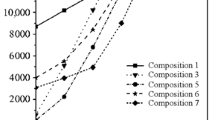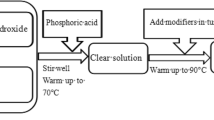Abstract
The data of DTA, IR spectroscopy, x-ray phase analysis, and chemical analysis are used to substantiate the temperature regime for heat treatment of unfired chamotte articles. It is shown that the desired strength and water resistance are provided by the formation of alumophosphates insoluble in water
Similar content being viewed by others
References
V. L. Golynko-Vol’fson, M. M. Sychev, L. G. Sudakas, and P. I. Skiblo,Chemical Foundations of the Technology and Applications of Phosphate Binders and Coats [in Russian], Khimiya, Leningrad (1968).
L. D. Pilipchatin, V. V. Peschanskaya, V. D. Troyan, and G. A. Belokrys, “Development of a resource-saving technology for manufacturing unfired articles for bottom casting of steel,”Ogneupory, No. 8, 27–29 (1996).
L. D. Pilipchatin, V. V. Peschanskaya, T. F. Shapovalova, et al., “Unfired refractories for bottom casting of steel,”Ogneupory, No. 9, 34–36 (1996).
A. K. Mendelenko, L. A. Tseitlin, N. V. Pitak, et al., “Interaction between kaolinite clay and orthophosphoric acid,”Ogneupory, No. 5, 43–48 (1977).
L. D. Pilipchatin, V. I. Kozdoba, A. S. Lutsenko, and V. V. Peschanskaya, “Determination of phosphor anhydride in gaseous products of heat treatment of clay-chamotte mixtures on orthophosphoric acid,”Ogneupory, No. 1, 17–20 (1993).
Author information
Authors and Affiliations
Rights and permissions
About this article
Cite this article
Pilipchatin, L.D. Choice of regime of heat treatment for unfired refractories on phosphate binder. Refract Ind Ceram 40, 301–303 (1999). https://doi.org/10.1007/BF02762573
Issue Date:
DOI: https://doi.org/10.1007/BF02762573




